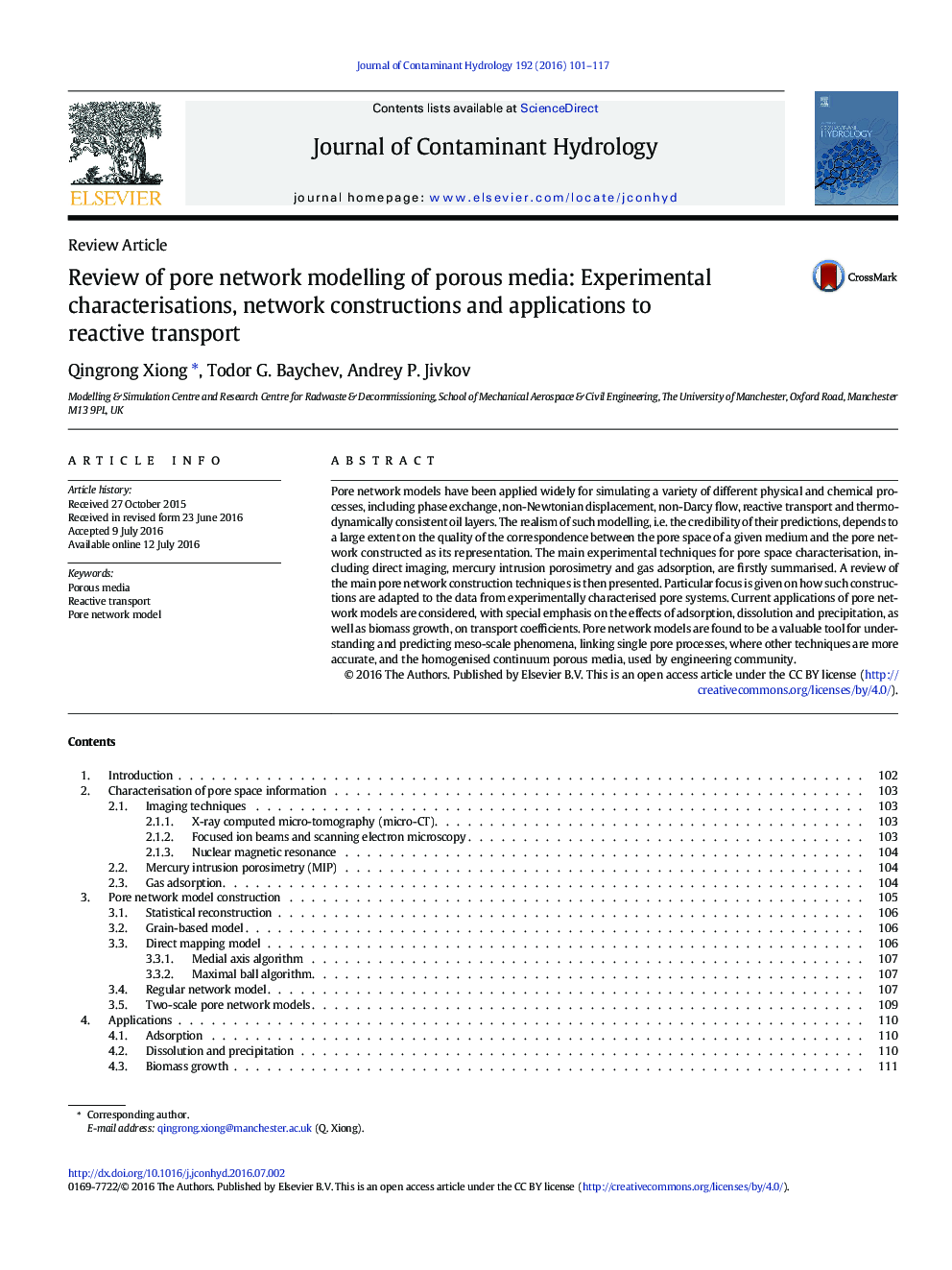| کد مقاله | کد نشریه | سال انتشار | مقاله انگلیسی | نسخه تمام متن |
|---|---|---|---|---|
| 6386344 | 1627019 | 2016 | 17 صفحه PDF | دانلود رایگان |
عنوان انگلیسی مقاله ISI
Review of pore network modelling of porous media: Experimental characterisations, network constructions and applications to reactive transport
ترجمه فارسی عنوان
بررسی مدلسازی شبکه های حفره ای رسانه های متخلخل: ویژگی های تجربی، سازه های شبکه و برنامه های کاربردی برای حمل و نقل واکنشی
دانلود مقاله + سفارش ترجمه
دانلود مقاله ISI انگلیسی
رایگان برای ایرانیان
کلمات کلیدی
رسانه های متخلخل، حمل و نقل مجدد، مدل شبکه پور
ترجمه چکیده
مدل شبکه های پوسته به طور گسترده ای برای شبیه سازی انواع فرآیندهای فیزیکی و شیمیایی مختلف، از جمله تبادل فاز، جابه جایی غیر نیوتنی، جریان غیر دارسی، انتقال واکنش پذیر و لایه های ترمودینامیکی پایدار استفاده شده است. واقع گرایی چنین مدل سازی، یعنی اعتبار پیش بینی های آن، تا حد زیادی بستگی به کیفیت مکاتبات بین فضای خالی یک رسانه خاص و شبکه حفاری ساخته شده به عنوان نمایندگی آن است. اصلی ترین تکنیک های تجربی برای مشخص کردن خصوصیات فضا، از جمله تصویربرداری مستقیم، نفوذ سنجی نفوذ جیوه و جذب گاز، در ابتدا خلاصه می شوند. پس از آن، بازبینی تکنیک های ساخت شبکه اصلی منافذ ارائه می شود. تمرکز ویژه در مورد چگونگی ساخت چنین سازه ها با داده های سیستم های منفی مشخص شده آزمایش شده است. کاربرد های جاری مدل های شبکه های منفی با تأکید ویژه بر اثرات جذب، انحلال و بارش، و همچنین رشد زیست توده، بر ضرایب حمل و نقل در نظر گرفته می شود. مدل شبکه های پور به عنوان یک ابزار ارزشمند برای درک و پیش بینی پدیده های مقیاسی در نظر گرفته می شود که متمایز کردن فرآیندهای منحصر به فرد، جایی که روش های دیگری دقیق تر است و رسانه های متخلخل همگن است که توسط جامعه مهندسی مورد استفاده قرار می گیرند.
موضوعات مرتبط
مهندسی و علوم پایه
علوم زمین و سیارات
فرآیندهای سطح زمین
چکیده انگلیسی
Pore network models have been applied widely for simulating a variety of different physical and chemical processes, including phase exchange, non-Newtonian displacement, non-Darcy flow, reactive transport and thermodynamically consistent oil layers. The realism of such modelling, i.e. the credibility of their predictions, depends to a large extent on the quality of the correspondence between the pore space of a given medium and the pore network constructed as its representation. The main experimental techniques for pore space characterisation, including direct imaging, mercury intrusion porosimetry and gas adsorption, are firstly summarised. A review of the main pore network construction techniques is then presented. Particular focus is given on how such constructions are adapted to the data from experimentally characterised pore systems. Current applications of pore network models are considered, with special emphasis on the effects of adsorption, dissolution and precipitation, as well as biomass growth, on transport coefficients. Pore network models are found to be a valuable tool for understanding and predicting meso-scale phenomena, linking single pore processes, where other techniques are more accurate, and the homogenised continuum porous media, used by engineering community.
ناشر
Database: Elsevier - ScienceDirect (ساینس دایرکت)
Journal: Journal of Contaminant Hydrology - Volume 192, September 2016, Pages 101-117
Journal: Journal of Contaminant Hydrology - Volume 192, September 2016, Pages 101-117
نویسندگان
Qingrong Xiong, Todor G. Baychev, Andrey P. Jivkov,
